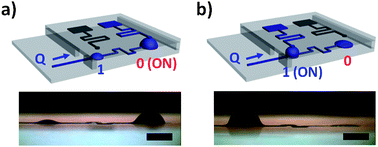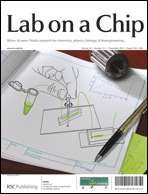Three-dimensional surface microfluidics enabled by spatiotemporal control of elastic fluidic interface†
Abstract
As an emerging alternative to the conventional counterpart, surface microfluidics incorporates both intrinsic resistive solid-liquid and elastic frictionless gas-liquid interfaces, leading to unique flow-pressure characteristics. Furthermore, the open-surface microfluidic platforms can be fabricated on a monolithic substrate with high wettability contrast by the previously reported one-step lithographic process of a photosensitive superhydrophobic nanocomposite material, which permits flexible fluidic operations and direct surface modifications. In the paper, we first present three-dimensional microfluidic manipulations utilizing the unconventional gas-liquid interfaces of surface microfluidics, outlined by the micropatterned wetting boundaries (also known as the triple lines). In contrast to the primary linear (resistive) nature of the conventional closed-


 Please wait while we load your content...
Please wait while we load your content...